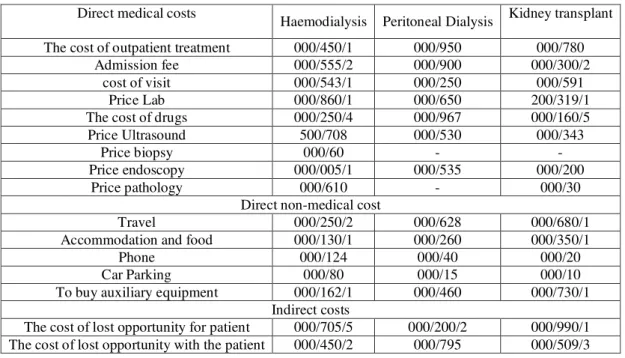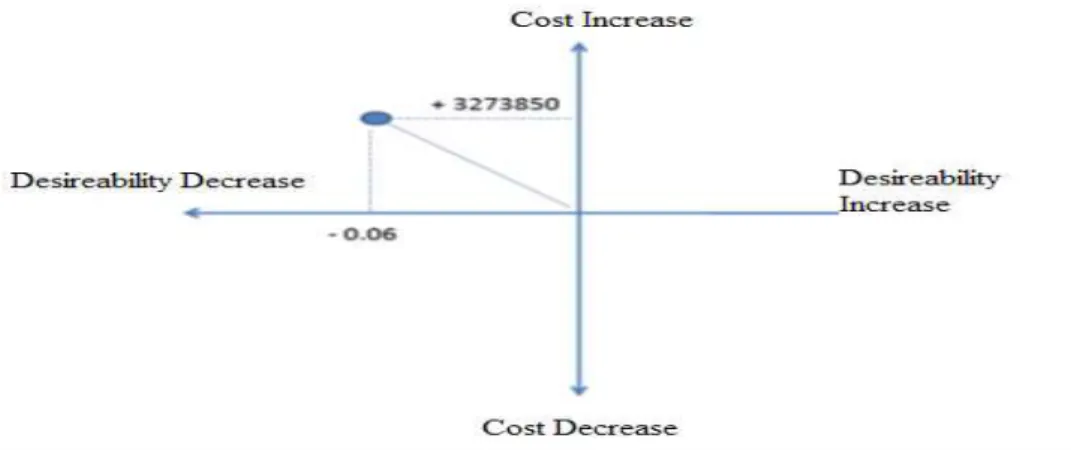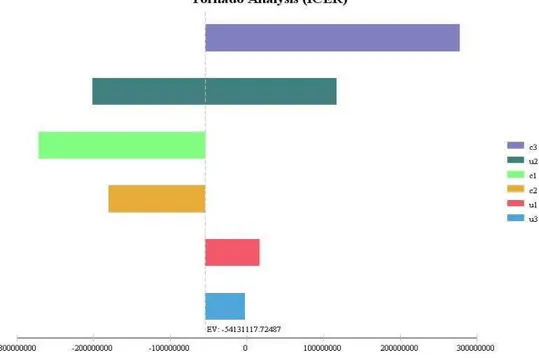Vol-7, Special Issue-Number2-April, 2016, pp560-565 http://www.bipublication.com
Case Report
Investigating the Cost - Utility
analysis Hemodialysis, Peritoneal Dialysis
and Kidney Transplantation in Patients with Kidney Failure in
Namazi Hospital in 2015
Hamidreza Azadi,2, Jamalledin Alvaani3 *
and Abbas Yazdanpanah1 and Abdosaleh Jafari4 1Department of healthcare management. Marvdasht Branch.
Islamic Azad University. Marvdasht . Iran 2Department Of Healthcare Management,
Fars Science and Research Branch, Islamic Azad University, Fars, Iran 3Department Of Psychology, Marvdasht Branch,
Islamic Azad University, Marvdasht Iran 4Health Management and Economics Research Center,
Iran University of Medical Sciences, Tehran, IR Iran *Corresponding author: Jamalledin Alvaani Address:Islamic Azad University, Marvdasht. Iran
Email:Dr.alvani@yahoo.com Fax:0713-234-2035Tel:09175317293
ABSTRACT:
Introduction: The growing trend of chronic kidney disease in the world represents an increase in problems that
impose to patient and his family and finally reduces quality of life and utility of patients. The aim of this study was to examine cost- utility of peritoneal dialysis, haemodialysis and kidney transplant.
Method: This was a cost-utility analysis done a cross-sectional study in 2015 on 85 patients with kidney failure
(peritoneal dialysis, hemodialysis and kidney transplant) in Namazi Teaching Hospital in Shiraz, Iran. Using decision tree, expected costs, utility and the incremental cost-effectiveness ratio (ICER) were estimated. In addition, the robustness of results was examined by one-way sensitivity analysis.
Results: The results of decision tree showed that in the dialysis arm, the expected cost was 103748850 IRR, and the
expected utility was 6.07 and in kidney transplant arm, the expected cost was 100475000 IRR and the expected utility was 6.13. According to the results of the study, kidney translation was cost-effective alternative to the dialysis.
Conclusion: Based on the results of this study, it is recommended that in the treatment of patients with kidney
failure, kidney transplant was use instead of dialysis. In addition, it is suggested the cost of kidney transplant covered by insurance organization.
Key words: cost-utility analysis- dialysis, haemodialysis, kidney transplant.
INTRODUCTION:
Renal failure is a major public health problem and a temporary or permanent kidney damage refers to which resulted in the loss of normal kidney function, the progressive and irreversible and usually leads to the end stage renal disease (1).
per million inhabitants and approximately 8% of this amount is added to (3)In Iran, despite attempts to prevent the disease, the number of patients is increasing in the country 4). This growing trend indicates that the number of patients on alternative treatments is increasing ( 5) Treatment of chronic renal failure and lead to change health status, performance, mental condition and well-being that all these factors affect a patient's quality of life (1). One of the most important tools in the health sector, makes it possible to compare the costs and outcomes of health experts, the economic evaluation. Cost - utility is the best and most useful techniques for this type of evaluation. Because in spite of life and quantity of life, considers the issue of quality of life. In this analysis, health interventions based on cost per unit is compared favourably and its goal is to maximize utility due to resource constraints (6). This study tries to calculate the cost of utility of the end-stage renal disease patients on haemodialysis treatment; peritoneal dialysis and kidney transplant costs and compare them with each other to identify the most appropriate method for the treatment of these patients.
METHOD:
This was a cost-utility analysis done a cross-sectional study in 2015 on 85 patients with renal failure (18 peritoneal dialysis patients, 27 haemodialysis patients and 40 patients with renal transplantation) in Namazi hospital that were selected in the census was conducted. In this study was to conduct a cost - utility of the decision tree was used which is the one shown in Fig. 1 the decision tree is a graphical representation of the diagnostic and therapeutic measures where the possibilities, cost and outcome of each track is shown. In Figure 1, numbers written on the bottom of the tree represents the possibility of dividing the total population of each branch is calculated. Eg 0.61 by dividing the number of haemodialysis patients is 27 and the total number of people on dialysis who are 45; is obtained. The numbers written on the bottom of the tree
represent the cost and utility of each branch. For example, c1 represents the cost of haemodialysis Patients is the amount of 107565000Rials.The cost and utility of each branch is written in the box above. In this study, using decision trees, expected cost and utility was calculated and incremental cost-effectiveness ratio (ICER) was estimated. Incremental cost-effectiveness ratio (ICER) was calculated by dividing difference cost to difference effectiveness in between two alternatives.(7)In addition to the strong results and deal with uncertainty, one-way sensitivity analysis was performed. (8)Data for this study was divided into two parts: the cost and utility.
The costs were calculated from the perspective of society and so direct medical costs; direct non-medical and indirect costs were estimated. In order to estimate the indirect costs , human capital method was used. In order to collect data, data collection forms were used which contains two parts, the first part included demographic characteristics and the second part contains information relating to the cost of outpatient treatment, admission fee, the cost of doctor visits, diagnostic tests and laboratory costs, the cost of accommodation, travel, parking and the cost of lost time and associated patient.In order to measure utility, time trade off method was used, that is the amount of time that people are willing the trade off of survival until they reach the indifference between the two options.
For example, Six months living with a disability versus living without disability.
This method was introduced in1972 by Torrance. (9) In fact, in this way, respondents must choose between the two models do health where a certain health status for a period becomes shorter and people are asked that an exchange or transaction between quality of life and length of life do. It is assumed that people choose the option that provides more utility values.
Figure A: Decision Tree dialysis compared to kidney transplant
RESULTS:
The results showed that of 85 patients, 61.2% male, 38.3% female and 42% were aged between 45 -65. In Table A, expense items related to patients, haemodialysis, peritoneal dialysis and kidney transplant breakdown of direct medical costs, non-medical direct and indirect costs is shown. The finding of this table shows that drug costs and most of the direct medical costs in kidney transplant patients, haemodialysis and peritoneal dialysis form. Moreover, in haemodialysis and peritoneal dialysis as well as travel costs for non-medical direct costs accounted
for most items in Table and Figure 2 shows the results of the decision tree.
The results of decision tree showed that in the dialysis arm, the expected cost was 103748850 IRR, and the expected utility was 6.07 and in kidney transplant arm, the expected cost was 100475000 IRR and the expected utility was 6.13. Dialysis compared to kidney transplant, Increased costs to 3273850 IRR and reduce utility to the amount of 0.06 .
Therefore, we can say that kidney transplantation compared to dialysis Is cost-effectiveness.
Table A: patients with kidney failure cost items based on the type of medical procedure
Kidney transplant Peritoneal Dialysis
Haemodialysis Direct medical costs
000/780 000/950
000/450/1 The cost of outpatient treatment
000/300/2 000/900 000/555/2 Admission fee 000/591 000/250 000/543/1 cost of visit
200/319/1 000/650 000/860/1 Price Lab 000/160/5 000/967 000/250/4 The cost of drugs
000/343 000/530 500/708 Price Ultrasound - - 000/60 Price biopsy 000/200 000/535 000/005/1 Price endoscopy 000/30 - 000/610 Price pathology
Direct non-medical cost
000/680/1 000/628 000/250/2 Travel 000/350/1 000/260 000/130/1 Accommodation and food
000/20 000/40 000/124 Phone 000/10 000/15 000/80 Car Parking 000/730/1 000/460 000/162/1 To buy auxiliary equipment
Indirect costs
000/990/1 000/200/2
000/705/5 The cost of lost opportunity for patient
000/509/3 000/795
000/450/2 The cost of lost opportunity with the patient
Table 2: cost and the expected utility of dialysis in kidney transplant
Options compared Expected cost
(Rial) Expected utility
Cost differences
Utility difference
Dialysis 103748850 6.07
3273850 -0.06
Kidney transplant 100475000 6.13
Figure 2: cost-utility analysis of dialysis compared to kidney transplant
In Figure 3, cost – effectiveness plan of dialysis in kidney transplant is drawn. In this diagram, the horizontal axis represents the change in effectiveness (utility) and the vertical axis represents the change in cost. This chart has 4 parts; in the North-East square, new intervention is more effective but more costly.
Square in the North - Western and South - East by old and new .06interventions are cost-effective and dominant and South-Western part of the new intervention in the square at the same time that is
less expensive, less effective exercise.(7)In the present study, dialysis compared to kidney transplant, Increased costs to 3273850 IRR and reduce utility to the amount of 0.06. and so findings in the northwestern part of the square are cost-effectiveness. Therefore suggests that dialysis is lost in kidney transplant or kidney transplantation compared to dialysis cost-effectiveness (dominant).
Sensitivity analysis
Given that any economic evaluation study accompanies uncertainty, in this study, a sensitivity analysis has been tried the sustainability and generalization of the results, the
test. Therefore, one-way sensitivity analysis was conducted and the amount of each of the variables increased by 20% it was prepared on the basis of a tornado graph (Figure 4).
Figure 4: Results of one-way sensitivity analysis (tornado charts)
Written numbers on the horizontal axis represents the amount of new ICER number represents the ICER amount of initial -54,131,117.72 which was calculated as follows:
ICER= = -54131117.72
Results Tornado graph shows the results in an increase in the cost of kidney transplantation (c3) the highest sensitivity and to increase the utility of kidney transplant (u3) is the least sensitive.
DISCUSSION AND CONCLUSION:
Economic evaluation, costs and results to compare two or more health interventions to achieve the best option and the overall goal is to maximize the benefits due to limitations in resources. Due to the economic problems of developing countries and the lack of resources, if economic evaluations in order to measure performance and optimal use of resources and information necessary financial
Marco model showed that kidney transplantation compared with dialysis, an increase in the rate of survival, quality of life and saving costs. (16) Jensen et al in their study in Denmark using the model showed that kidney transplantation compared to dialysis Marco cost - effectiveness and an increase in quality-adjusted life years (quality-adjusted life year) as well as the cost savings so that the cost per quality-adjusted life year unit for dialysis and kidney transplant is respectively 1,032,934 DKK and 810,516 DKK. (17) Senfalt et al in their study in Sweden showed that using decision tree method of peritoneal dialysis compared to haemodialysis; as initial therapy in patients with renal failure is cost-effective. (18) Pacheco and colleagues showed their study in Chile between peritoneal dialysis and haemodialysis, in terms of quality of life, cost - utility dues were not significantly different. (19) In the present study to verify, the results of economic evaluation (ICER) were conducted sensitivity analysis that determines the outcome could determine the economic evaluation.
The results of the sensitivity analysis was
performed with a 20 present increase in data, ICER to increase the cost of kidney transplantation showed the greatest sensitivity, given that in this case ICER value is a positive number. It can be said that the cost - utility of dialysis in kidney transplant cannot be said with certainty decision and the need to make decisions based on the threshold. In order to calculate the threshold can be used by the World Health Organization (referenced below), so that if GDP per capita is less than three times the amount of ICER, the study cost - effective and otherwise study is not cost-effective. (20)
In connection with the generalization of the results of this study can be given that dialysis Iran and kidney transplant in other hospitals in the treatment of kidney disease used. The results of this study can be generalized to them but given that the costs covered by insurance organizations, paid by patients and the incidence and prevalence of kidney disease is different in different
countries. The results of this study cannot be generalized with certainty to other countries.
CONCLUSION:
According to the results, it is recommended to treat patients with renal failure, used instead of dialysis kidney transplantation as well as the cost of kidney transplantation covered by insurance organizations.
REFRENCES
1) Esmaeli Shamirzadi S, Moradian Sorkhkolaei M, Azam K. Determination of Quality of Life of Dialysis and Kidney Transplant Patients Compared of Healthy People. Health System Research. 2011;7(6):1170-7.
2) Iliescu EA, Coo H, McMurray MH, Meers CL ,Quinn MM, Singer MA, et al. Quality of sleep and health‐related quality of life in haemodialysis patients. Nephrology Dialysis Transplantation. 2003;18(1):126-32.
3) Brunner LS, Smeltzer SCC, Bare BG, Hinkle JL, Cheever KH. Brunner & Suddarth's textbookof medical-surgical nursing: Lippincott Williams & Wilkins; 2010. 4) Larijani B, Zahedi F, Taheri E, editors.
Ethical and legal aspects of organ transplantation in Iran. Transplantation proceedings; 2004: Elsevier.
5) sharifnia h, aghakhani n, nazari r, nahrir b. A Comparative Study of Quality of Life ( QOL) Among Patients with Haemodialysis and Peritoneal
6) Fox-Rushby J, Cairns J. Economic evaluation: McGraw-Hill International; 2005 7) Drummond MF, Sculpher MJ, Claxton K,
Stoddart GL, Torrance GW. Methods for the economic evaluation of health care programmes: Oxford university press; 2015 8) Taylor M. What is sensitivity analysis?
Heslington: University of York; 2009. 9) Churchill, D., Torrance, G., Taylor, D., et al.
approach. Clinical and Investigative Medicine, 10, 14-20
10) Eckard N, Janzon M, Levin L-Å. Use of cost-effectiveness data in priority setting decisions: experiences from the national guidelines for heart diseases in Sweden. Int J Health Policy Manag. 2014;3:323-32.
11) Taheri N, Kamalgar S, Cheragian B. Study of Quality of life in patients with hemodialysis, danesh and tanderosty Quarterly, 2014, 8(3). 12) Mohammadpourtahamtan R, Health-related
quality of life in people over 40 years old living in Mazandaran, payesh Quarterly,2013 13) Vahdaninia M, Goshtasebi A, Montazeri A, Rahimi A, Mohammad K. Self-reported health and socioeconomic status results from a population-based study in Tehran, Iran. Payesh (Health Monitor) 2003 ;-
14) Jafari A , Ravangard R , Estimation of the demand for health for urban households using Grossmans model in Shiraz Iran, prog health sci, 2014
15) Karimi I, Vianchi A. Comparative study of cost- effectiveness of Dialysis and kidney transplant using DALY index in Shahid Haseheminejad Hospital. Journal of health management and informatics. 2004;16:46-50. Persian
16) Rosselli D1, Rueda JD, Diaz CE. Cost-effectiveness of kidney transplantation compared with chronic dialysis in end-stage renal diseaseSaudi J Kidney Dis Transpl. 2015 Jul-Aug;26(4):733-8.
17) Jensen CE1, Sørensen P, Petersen KD In Denmark kidney transplantation is more cost-effective than dialysis Dan Med J. 2014 Mar;61(3):A4796.
18) Sennfält K1, Magnusson M, Carlsson P. Comparison of hemodialysis and peritoneal dialysis--a cost-utility analysis. Perit Dial Int. 2002 Jan-Feb;22(1):39-47.
19) Pacheco A1, Saffie A, Torres R, Tortella C, Llanos C, Vargas D, Sciaraffia V
Cost/Utility study of peritoneal dialysis and
hemodialysis in Chile. Perit Dial Int. 2007 May-Jun;27(3):359-63.


